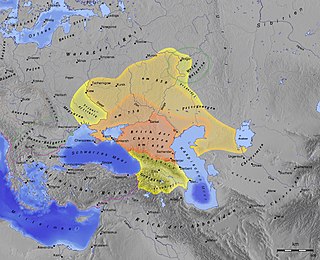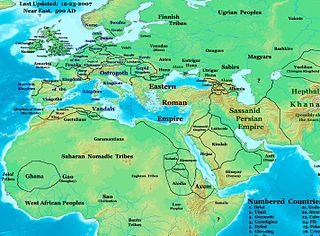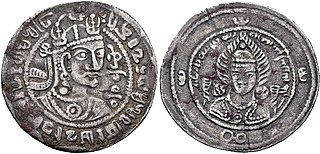Related Research Articles

The Khazars were a semi-nomadic Turkic people that in the late 6th-century CE established a major commercial empire covering the southeastern section of modern European Russia, southern Ukraine, Crimea, and Kazakhstan. They created what for its duration was the most powerful polity to emerge from the break-up of the Western Turkic Khaganate. Astride a major artery of commerce between Eastern Europe and Southwestern Asia, Khazaria became one of the foremost trading empires of the early medieval world, commanding the western marches of the Silk Road and playing a key commercial role as a crossroad between China, the Middle East and Kievan Rus'. For some three centuries the Khazars dominated the vast area extending from the Volga-Don steppes to the eastern Crimea and the northern Caucasus.

The Bulgars were Turkic semi-nomadic warrior tribes that flourished in the Pontic–Caspian steppe and the Volga region during the 7th century. They became known as nomadic equestrians in the Volga-Ural region, but some researchers say that their ethnic roots can be traced to Central Asia. During their westward migration across the Eurasian steppe, the Bulgar tribes absorbed other tribal groups and cultural influences in a process of ethnogenesis, including Iranian, Finnic and Hunnic tribes. Modern genetic research on Central Asian Turkic people and ethnic groups related to the Bulgars points to an affiliation with Western Eurasian populations. The Bulgars spoke a Turkic language, i.e. Bulgar language of Oghuric branch. They preserved the military titles, organization and customs of Eurasian steppes, as well as pagan shamanism and belief in the sky deity Tangra.

The Sabirs were nomadic people who lived in the north of the Caucasus beginning in the late-5th -7th century, on the eastern shores of the Black Sea, in the Kuban area, and possibly came from Western Siberia. They were skilled in warfare, used siege machinery, had a large army and were boat-builders. They were also referred to as Huns, a title applied to various Eurasian nomadic tribes in the Pontic-Caspian Steppe during late antiquity. Sabirs led incursions into Transcaucasia in the late-400s/early-500s, but quickly began serving as soldiers and mercenaries during the Byzantine-Sasanian Wars on both sides. Their alliance with the Byzantines laid the basis for the later Khazar-Byzantine alliance.

Kubrat was the ruler of the Onogur–Bulgars, credited with establishing the confederation of Old Great Bulgaria in ca. 632. His name derived from the Turkic words qobrat — "to gather", or qurt, i.e. "wolf".
The Onoğurs or Oğurs, were Turkic nomadic equestrians who flourished in the Pontic–Caspian steppe and the Volga region between 5th and 7th century, and spoke the Oghuric language.
The Akatziri or Akatzirs were a tribe that lived north of the Black Sea, though the Crimean city of Cherson seemed to be under their control in the sixth century. Jordanes called them a mighty people, not agriculturalists but cattle-breeders and hunters. Their ethnicity is undetermined: the 5th-century historian Priscus describes them as ethnic (ethnos) Scythians, but they are also referred to as Huns. Their name has also been connected to the Agathyrsi. However, according to E. A. Thompson, any conjectured connection between the Agathyrsi and the Akatziri should be rejected outright.

The Dulo clan was a ruling dynasty of the Bulgars. The origins of the Bulgars and Dulo clan are not known precisely, and there are many theories about their origin. It is generally considered that they – or at least the elite caste – were intimately related to the origin and activity of the Huns and Western Turkic Khaganate. Particularly, it is said that the Dulo descended from the rulers of Great Bulgaria, which was founded by Khan Asparuh's (681–701) father on the steppes of Ukraine. This state was a centralized monarchy from its inception, unlike previous Hunno-Turkic political entities, which were tribal confederations.
Khazar, also known as Khazaric, was a Turkic dialect group spoken by the Khazars, a group of semi-nomadic Turkic peoples originating from Central Asia. There are few written records of the language and its features and characteristics are unknown. It is believed to have gradually become extinct by the 13th century AD as its speakers assimilated into neighboring Turkic-speaking populations.

Elteber was the client king of an autonomous but tributary tribe or polity in the hierarchy of the Turkic khaganates including Khazar Khaganate.
Esegels were a dynastic tribe, of Turkic linguistic affiliation, in the Middle Ages who joined and would be assimilated into the Volga Bulgars.

Peter Benjamin Golden is an American historian who is Professor Emeritus of History, Turkish and Middle Eastern Studies at Rutgers University. He has written many books and articles on Turkic and Central Asian Studies, such as An introduction to the history of the Turkic peoples.
The Turkic migrations were the spread of Turkic tribes and Turkic languages across Eurasia and between the 6th and 11th centuries. In the 6th century, the Göktürks overthrew the Rouran Khaganate in what is now Mongolia and expanded in all directions, spreading Turkic culture throughout the Eurasian steppes. Although Göktürk empires came to an end in the 8th century, they were succeeded by numerous Turkic empires such as the Uyghur Khaganate, Kara-Khanid Khanate, Khazars, and the Cumans. Some Turks eventually settled down into sedentary societies such as the Qocho and Ganzhou Uyghurs. The Seljuq dynasty settled in Anatolia starting in the 11th century, resulting in permanent Turkic settlement and presence there. Modern nations with large Turkic populations include Kyrgyzstan, Turkmenistan, Turkey, Azerbaijan, Uzbekistan and Kazakhstan, and Turkic populations also exist within other nations, such as Chuvashia, Bashkortostan, Tatarstan, the Crimean Tatars, the Kazakhs in Mongolia, the Uyghurs in China, and the Sakha Republic in Siberia.

Kutrigurs were Turkic nomadic equestrians who flourished on the Pontic–Caspian steppe in the 6th century AD. To their east were the similar Utigurs and both possibly were closely related to the Bulgars. They warred with the Byzantine Empire and the Utigurs. Towards the end of the 6th century they were absorbed by the Pannonian Avars under pressure from the Turks.
The Oghuric, Onoguric or Oguric languages are a branch of the Turkic language family. The only extant member of the group is the Chuvash language. The first to branch off from the Turkic family, the Oghur languages show significant divergence from other Turkic languages, which all share a later common ancestor. Languages from this family were spoken in some nomadic tribal confederations, such as those of the Onogurs or Ogurs, Bulgars and Khazars.
The Saragurs or Saraguri was a Eurasian Oghur (Turkic) nomadic tribe mentioned in the 5th and 6th centuries. They may be the Sulujie mentioned in the Chinese Book of Sui. They originated from Western Siberia and the Kazakh steppes, from where they were displaced north of the Caucasus by the Sabirs.
Basiq or Basich was a Hun military commander and royal family member who led an invasion of Persia in 395 AD.
Tyranx was a Hun general and sub-king, or king of a Hunnish tribe, fighting for the Sasanian Empire.
The Attilids were a leading dynasty of the Huns, a nomad pastoralist people who confronted the Roman Empire during the decline of the Western Roman Empire, as well as the Eastern Roman Empire. They also often fought in alliance with both of these empires against the invading Germanic people.
References
- ↑ Jeffreys, Elizabeth; Jeffreys, Michael; Scott, Roger (1986). The Chronicle of John Malalas. Brill. p. 340. ISBN 9789004344600 . Retrieved 15 November 2022.
- 1 2 Martindale, J.R. (1992). The Prosopography of the Later Roman Empire 2 Part Set: Volume 3, AD 527-641. Cambridge University Press. p. 1346. Retrieved 15 November 2022.
- ↑ Evan Michael Schultheis (30 January 2019). The Battle of the Catalaunian Fields AD 451: Flavius Aetius, Attila the Hun and the Transformation of Gaul. ISBN 978-1526745668.
- ↑ Golden 1980, p. 258.
- ↑ Golden 1992, p. 106.
- ↑ Justi, Ferdinand (1895). Iranisches Namenbuch . Marburg: NG Elwertsche Verlagsbuchhandlung, p. 112.